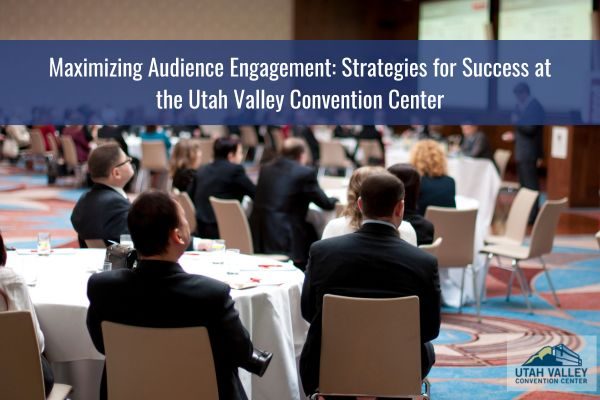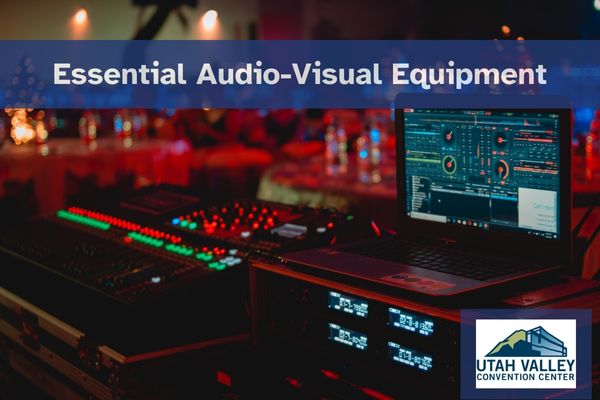Attracting your ideal audience is essential for the success of any event, especially if you have hefty revenue and sales goals to hit. The Utah Valley Convention Center located in Provo, Utah understands it is crucial to recognize the needs, preferences, and pain points of your target attendees. Here are some key strategies to help you in your messaging and marketing efforts.

How to Host a Successful Event at a Convention Center
Hosting a successful event at a convention center requires meticulous planning and attention to detail.
Here’s a step-by-step guide to help you:
- Define Your Objectives: Clearly outline the purpose of your event. Determine what you want to achieve, whether it is networking, education, promotion, or fundraising.
- Choose the Right Venue: Select a convention center that suits your event’s size, location, and facilities. Consider factors like accessibility, parking, accommodation options, and technological capabilities.
- Set a Budget: Determine your budget early on and allocate funds for venue rental, marketing, equipment, staff, catering, and other expenses. Be realistic and account for unforeseen costs.
- Plan the Logistics: Create a detailed timeline and checklist covering all aspects of the event, from initial planning to post-event evaluation. Coordinate with vendors, speakers, sponsors, and exhibitors to ensure everything runs smoothly.
- Promote Your Event: Develop a comprehensive marketing strategy to attract attendees. Utilize various channels such as social media, email marketing, press releases, and partnerships with relevant organizations or influencers.
- Design Engaging Content: Curate a compelling program agenda with informative sessions, workshops, keynote speakers, and interactive activities. Tailor the content to your target audience’s interests and preferences.
- Provide Excellent Facilities: Ensure the convention center offers state-of-the-art technology, comfortable seating, sufficient lighting, and appropriate acoustics. Arrange for amenities like Wi-Fi access, charging stations, and signage for easy navigation.
- Offer Networking Opportunities: Facilitate networking opportunities for attendees to connect with peers, industry experts, and potential partners. Schedule networking breaks, receptions, and social events to encourage interaction and relationship-building.
- Focus on Attendee Experience: Pay attention to every detail to create a positive experience for attendees. Offer perks like swag bags, giveaways, exclusive access, and on-site support to enhance satisfaction and engagement.
- Implement Effective Event Management: Assign roles and responsibilities to a capable team to oversee event logistics, registration, security, and customer service. Have contingency plans in place to address any issues or emergencies that may arise.
- Gather Feedback: After the event, solicit feedback from attendees, exhibitors, and sponsors to evaluate its success and identify areas for improvement. Use this information to refine future events and maintain positive relationships with stakeholders.
Planning an Event near Provo, Utah?
Use the free estimate tool from Utah Valley Convention Center!
By following these steps and dedicating time and effort to planning and execution, you can host a successful event at a convention center that leaves a lasting impression on attendees and achieves your objectives.
How to Maximize Attendance When Hosting an Event?
Maximizing attendance at your event involves strategic planning and effective promotion to reach and engage your target audience. Here are some tips to help you maximize attendance:
- Identify Your Target Audience: Understand who your ideal attendees are and tailor your event to meet their interests, needs, and preferences. This will help you create compelling content and marketing messages that resonate with them.
- Start Early: Begin promoting your event well in advance to generate anticipation and build momentum. Create a timeline for your promotional activities, including pre-event teasers, early bird discounts, and reminders leading up to the event.
- Utilize Multiple Channels: Diversify your marketing efforts by leveraging various channels to reach a wider audience. This may include social media platforms, email marketing, website/blog posts, online communities, industry publications, direct mail, and partnerships with relevant organizations or influencers.
- Create Compelling Content: Develop engaging and informative content that highlights the value proposition of attending your event. This could include teaser videos, speaker interviews, sneak peeks of sessions, case studies, testimonials, and interactive elements that encourage participation.
- Offer Incentives: Provide incentives to encourage early registration and attendance. This could include early bird discounts, group rates, exclusive access to content or networking opportunities, giveaways, contests, or special promotions for referrals.
- Optimize Registration Process: Make it easy for people to register for your event by streamlining the registration process. Use an intuitive online registration platform that allows for quick and secure sign-up, offers multiple ticket options, and provides instant confirmation.
- Engage Your Audience: Foster engagement with your target audience before, during, and after the event. Encourage interaction on social media platforms using event hashtags, host live Q&A sessions, polls, and discussions, and create opportunities for networking and peer-to-peer collaboration.
- Leverage Influencers and Partnerships: Partner with industry influencers, thought leaders, or relevant organizations to extend your reach and credibility. Encourage them to promote your event to their followers or members, either through sponsored content, guest blog posts, social media mentions, or speaking engagements.
- Create a Sense of Urgency: Use scarcity and urgency tactics to encourage immediate action. Offer limited-time promotions, highlight diminishing ticket availability, or countdown to key milestones to create a sense of FOMO (fear of missing out) among potential attendees.
- Follow Up Post-Event: Keep the momentum going even after the event has ended. Follow up with attendees to thank them for participating, gather feedback through surveys or polls, share highlights and key takeaways, and nurture ongoing relationships through email newsletters or exclusive content.
By implementing these strategies and continuously refining your approach based on feedback and analytics, you can maximize attendance at your event and ensure its success.
Tips For Attracting Your Ideal Audience for an Event
Attracting your ideal audience involves understanding their needs, preferences, and pain points, and then tailoring your messaging and marketing efforts to resonate with them. Here are some tips to help you attract your ideal audience:
- Define Your Ideal Audience: Start by clearly defining who your ideal audience is. Consider demographic factors such as age, gender, location, income level, occupation, as well as psychographic factors such as interests, values, attitudes, and behaviors.
- Conduct Market Research: Gather data and insights about your target audience through market research, surveys, interviews, and analysis of customer feedback. Understand their challenges, motivations, goals, and preferences related to your industry or niche.
- Create Buyer Personas: Develop detailed buyer personas that represent your ideal audience segments. These personas should include demographic information, pain points, goals, preferences, objections, and preferred communication channels.
- Tailor Your Messaging: Craft messaging that speaks directly to the needs and interests of your target audience. Use language, tone, and imagery that resonates with them and highlights the benefits of your product or service in addressing their specific pain points or desires.
- Provide Value: Offer valuable content, resources, or solutions that address the needs and interests of your ideal audience. This could include blog posts, articles, how-to guides, tutorials, webinars, case studies, templates, or free tools that demonstrate your expertise and build trust.
- Choose the Right Channels: Identify the channels where your target audience is most active and present your message there. This could include social media platforms, online forums, industry-specific websites, email newsletters, podcasts, or offline events and publications.
- Optimize Your Website and Content: Ensure that your website and content are optimized for search engines (SEO) to attract organic traffic from people searching for relevant keywords or topics. Use targeted keywords, meta tags, headers, and high-quality content that addresses the needs of your ideal audience.
- Utilize Paid Advertising: Consider using paid advertising platforms such as Google Ads, social media ads, or sponsored content to reach your ideal audience more effectively. Use targeting options such as demographics, interests, behaviors, and retargeting to narrow down your audience and maximize ROI.
- Engage and Interact: Foster engagement with your target audience by responding to comments, messages, and inquiries promptly. Encourage interaction through polls, surveys, quizzes, contests, or interactive content that encourages participation and feedback.
- Monitor and Analyze Results: Continuously monitor the performance of your marketing efforts and analyze the data to understand what resonates most with your ideal audience. Use analytics tools to track website traffic, social media engagement, conversion rates, and other key metrics to optimize your strategies over time.
By implementing these tips and consistently refining your approach based on feedback and insights, you can attract and engage your ideal audience more effectively, ultimately driving growth and success for your business or organization.
Conclusion
In conclusion, attracting your ideal audience to an event hosted at the Utah Valley Convention Center (or any venue!) requires a strategic approach that considers the unique characteristics and preferences of your target attendees.
By defining your audience, crafting compelling messaging, providing value, and engaging through various channels, you can maximize attendance and work to hit those sales and revenue goals for the event. Work with a venue who has your vision and benchmarks in mind. Use our Event Estimate Tool to plan your next event.





